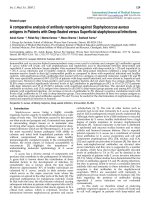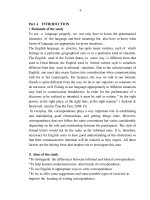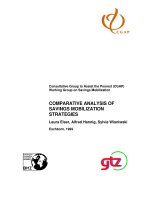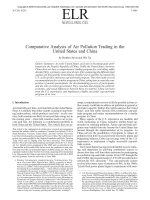COMPARATIVE ANALYSIS OF TEXTURAL PROPERTIES OF SBA-15
Bạn đang xem bản rút gọn của tài liệu. Xem và tải ngay bản đầy đủ của tài liệu tại đây (187.07 KB, 5 trang )
551
COMPARATIVE ANALYSIS OF TEXTURAL PROPERTIES OF SBA-15
PREPARED FROM RICE HUSK AND TETRAETHYLORTHOSILICATE
Thanh Ho Van
Thua Thien Hue college of Education
Received 10 March 2011
Abstract
SBA-15 materials were synthesized using rice husk. In addition, SBA-15 was synthesized by using
tetraethylorthosilicate as a reference material. The obtained materials were characterized by XRD, TEM and
adsorption/desorption nitrogen method. Though less ordered hexagonal mesoporous SBA-15 materials could be
obtained from rice husk they exhibit high surface area and large pore size in comparison with one from
tetraethylorthosilicate. Morphology of SBA-15 prepared from rice husk consists of curve-rod like silicas while that of
SBA-15 from tetraethylorthosilicate consists of rod-like silicas. The difference in mesoporous tubular structure and
textural properties of synthesized SBA-15 could be assigned to inherent impurities of metal ions in rice husk.
1. INTRODUCTION
Rice husk is a by-product from rice mill that was
used as an energy source in many industries such as
biomass power plant and rice mill. Rice husk is rich
in silica and can be an economically valuable raw
material for production of natural silica [1, 2]. In
Vietnam, a large amount of rice husk is produced
and practically used later in agriculture as low-value
material.
Highly ordered large-pore mesoporous silica
SBA-15, which has considerably thicker pore walls
than MCM-41 was recently synthesized in acid
media using amphiphilic triblock copolymer as the
structure-directing agent and various silica sources:
sodium silicate, tetraethylorthosilicate (TEOS) [3].
Thus silica source from rice husk would be
alternative for synthesis of SBA-15. This benefit is
to enhance the rice husk value.
In this paper, SBA-15 was prepared by using
silica source from rice husk. The textural properties
were then compared with those of SBA-15
synthesized from tetraethylorthosilicate (TEOS).
2. EXPERIMENTAL
Raw materials used in this paper were rice husk
collected from Thua Thien Hue province. Silica
solution was extracted from rice husk under
refluxing in NaOH solution. Obtained filtrate was
used as silica source. The SBA-15 sample was
synthesized by using triblock copolymer (P123) as
surfactant and rice husk as silica source [4]. The
molar ratios of reactant were 1SiO
2
: 0.0167P123:
5.16 HCl: 162 H
2
O. P123 was dissolved in distilled
water until a clear solution was obtained before an
addition of HCl and silica solution to form
precipitation. Finally, the resulting solid product was
filtered, washed with distilled water, dried at 373 K
for 24 hours and then calcined at 773 K for 10 hours.
The obtained SBA-15 materials were denoted as
RH-SBA-15. In addition, SBA-15 was synthesized
by using TEOS as a reference material by
procedures described by Stucky et al [3] and denoted
as TEOS-SBA-15.
The silica content of dried rice husk was
analyzed by gravimetric method.
Nitrogen adsorption/desorption isotherms of
calcined samples were obtained using Omnisorp-100
sorptometer at 77K, after degassing at 200
o
C and 10
-
5
mmHg for at least 4 hours. The specific surface
areas (S
BET
) were calculated by the standard BET
method for adsorption data in a relative pressure
range from 0.05 to 0.3 [5] The pore-size distribution
(PSD) was determined by the Barrett-Joyner-
Halenda (BJH) method from desorption isotherm
data. Primary mesopore diameter, d
p
, was
determined from the maximum of a PSD curve. t-
plot method has been applied to quantitatively
determine the mesopore surface area (denoted as
S
BJH
). The t is a function of relative pressure
expressed as Eq. 1 [6].
1
2
13.99
0.034 log
o
t
P
P
=
−
(1
)
VIETNAM JOURNAL OF CHEMISTRY VOL. 49(5) 551-555 OCTOBER 2011
552
Usually, when micropores are present the t-plot
will exhibit a positive intercept from which the
micropore volume is calculated. Using the slop(s) of
linear part of the t-plot in the range 0.45 < t < 1.0
nm, the mesopore surface area S
BJH
can be calculated
by Eq. 2, considering mesoporous surface as
external one of material.
47.15
×
=
sS
BJH
(2)
The constant 15.47 represents the conversation
of the gas volume to liquid volume. The micropore
surface area can be therefore calculated as the
difference between the total surface area S
BET
and the
mesopore surface area S
BJH
.
The total pore volume V
t
was determined from
the amount of nitrogen absorbed at 77 K at the
relative pressure of 0.99. At such a pressure the main
channels of the sample are assumed to be completed
filled with nitrogen. The total mesopore volume was
obtained by integrating the PDS curves from pore
size of about 2.0 nm to the upper limit of 50 nm. The
micropore volumes were calculated from the
difference between total pore volume V
t
and total
mesopore volume
The mesoporous phases of Si-SBA-15 were
monitored by powder low-angle X-ray diffraction
(XRD), recorded on 8D Advance (Bruker, Germany)
with CuK
α
radiation in the range of 2θ from 0.5 to
10
o
with a scan step size of 0.01
o
and a scan step
time of 0.04s. The length of the hexagonal “unit
cell” a
o
was calculated using the formula
100
2
3
o
d
a =
[6]. Pore wall thickness, t
w
, was assessed
by subtracting d
p
from a
o
. The morphology was
studied by TEM (JEM microscopy-1010).
3. RESULTS AND DISCUSSION
The silica content of rice husk was analyzed by
gravity method. This amount of SiO
2
was obtained
up to considerable values. The amount of impurities
was also found such as CaO, MgO, MnO
2
etc. The
results of element analysis were listed on table 1.
SiO
2
CaO MgO MnO
2
Na
2
O K
2
O
8.96% 0.0024% 0.0026% 0.0043% 0.0200% 0.0300%
It is noted that the silica source from rice husk
contains remarkable amount of transition metals
including magnesium, calcium, magnesium etc.
while one from TEOS does not. Thus the textural
properties of synthesized SBA-15 materials should
depend on silica sources.
Fig. 1 shows XRD patterns of RH-SBA-15 and
TEOS-SBA-15. Three reflections of mesoporous
phases were found at low angle reflection which
were indexed as (100), (110), and (200) [7]. These
sharp signals indicated the long-range orders of the
uniform hexagonal mesoporous structure. It is noted
that in the case of RH-SBA-15, the peak (100) is
broader than that of TEOS-SBA-15. The d
spacing
of
(100) peak increases from 10.4 nm for TEOS-SBA-
15 to 11.7 nm for RH-SBA-15. This implies the
enlargement of the distance between two centers of
adjacent pores (“unit cell” a
o
) in hexagonal
arrangement. This effect may be due to the
introduction of metals as impurities in rice husk in
which the Me-O bond are longer than the Si-O bond.
0 2 4 6 8 10
(200)
(110)
(100)
2 thetha (degree)
Intensity (arb. units)
RH-SBA-15
TEOS-SBA-15
Fig. 1: The XRD patterns of RH-SBA-15 and TEOS-SBA-15 materials
VJC, Vol. 49(5), 2011 Ho Van Thanh
553
Figs. 2 and 3 show TEM observations of TEOS-
SBA-15 and RH-SBA-15, respectively. Both top and
side views obtained from TEM indicate the well-
ordered hexagonal mesoporous structure for all
samples. The cross sectional patterns showed
hexagonal structure which is the distinctive feature
of SBA-15. The pore diameters estimated from the
top view were approximately 4-5 nm for both SBA-
15. The highly ordered TEOS-SBA-15 consists of
the gathering of rod-like silica while RH-SBA-15
consists of curve-rod like silica.
The nitrogen adsorption-desorption isotherms of
RH-SBA-15 and TEOS-SBA-15 were shown in Fig.
3. Very similar type IV isothermers and large
desorption hysteresis were observed for both
samples, which is characteristic of mesoporous
materials with cylindrical pores.
Fig. 2: TEM images of TEOS-SBA-15: side view (a) and top view (b)
Fig. 3: The TEM images of RH-SBA-15: side view (a) and top view (b)
The textural parameters of mesoporous silicas
calculated from adsorption/desorption nigtrogen data
are summarized in table 2. As can be seen, S
BET
of
RH-SBA-15 is rather higher than that of TEOS-
SBA-15. Even d
p
of RH-SBA-15 is larger than that
TEOS-one its S
mes
is lower than that of TEOS-SBA-
15. The increasing total surface area for RH-SBA-15
should be related to the formation of microporosity.
a b
a
b
50 nm
VJC, Vol. 49(5), 2011 Comparative analysis of textural properties…
554
Fig. 4: Adsorption/desorption nitrogen isotherms of SBA-15 synthesized from TEOS and rice husk
Table 2: Textural properties of synthesized SBA-15 samples
Sample S
BET
(m
2
.g
-1
) S
mes
(m
2
.g
-1
) S
mic
(m
2
.g
-1
) d
p
(Å) V
mes
(cm
3
.g
-1
) t
w
(Å)
TEOS-SBA-15 626.0 511.9 114.1 77.2 1.17 43.4
RH-SBA-15 733.7 466.4 267.3 91.3 1.43 37.7
It is clear that the polymer-ion interaction plays
an important role in the morphology. In fact, it is
well-known that metal ions form crown-ether-type
complexes with polymeric PEO and PPO units [8],
the multivalent metal species (M
n+
) can associate
preferentially with the hydrophilic PEO moieties,
because of their different binding affinities for PEO
and PPO. It is known that, the SBA-15 materials are
prepared by the use of nonionic surfactants as
organic structure directing agents in acid media via
(S
0
H
+
)(X
-
I
+
) synthesis route where S
0
is nonionic
surfactant, H
+
proton, X
-
acid anion, and I
+
protonated silanol group.
O
C
C
C
O
C
C
O
Me
n+
Cl
Cl
Fig. 5: Molecular model of the transition metal-PEO
interaction
In the case of synthesis mixture containing metal
ions, the modified pathway can be now denoted as
N
0
[(M
n+
H
+
)X
-
]I
+
, where M
n+
is metal ions such as
Mn
2+
, Mg
2+
, K
+
, etc. Thus, the proposed assembly
mechanism for these diverse mesoporous metal
oxides includes PEO-metal chelating interactions in
conjunction with electrostactics, van der Waals
forces, ect., to direct mesostructure formation.
Futhermore, since the structure directing effect is
irrespective of the anions used in the synthesis, and
only the Cl
-
anion resulted in a branched, network-
like structure, presumably the complex symmetry as
illustrated in Fig. 5 may also play an important role
in the synthesis by modification of the electrostatic
interaction or the local curvature energy at the
interface of the inorganic silica and the surfactant
4. CONCLUSIONS
Synthesis of SBA-15 material from rice husk
was investigated. The obtained SBA-15 material
possesses high specific surface area, large pore
diameter. The silica from rice husk can be utilized
for synthesis of SBA-15 material instead of
commercial silica.
REFERENCES
1. A. A. M. Daifullah, B. S. Girgis, H. M. H. Gad.
Utilization of argo-residues (rice husk) in small
0.0 0.2 0.4 0.6 0.8 1.0
200 cm
3
.g
-1
TEOS-SBA15
Quantity Adsorbed (cm³/g STP)
Relative Pressure (P/Po)
RH-SBA15
VJC, Vol. 49(5), 2011 Ho Van Thanh
555
waste water treatment plans, Material letters, 57,
1723-1731 (2003).
2. Siriluk Chiarakorn, Nurak Grisdanurak, and R. C.
Miller. Analysis of nitrogen and carbon
tetrachloride adsorption isotherms and pore size
distribution for siliceous MCM-41 synthesized from
rice husk silica, Environment & Hazardous
Management, 26, 37-44 (2004).
3. C. T. Krespe, M. E. Lenowicz, W. J. Roth, J. C.
Vartuli, and S. Beck. Ordered mesoporous
molecular sieves synthesized by a liquid-crystal
template mechanism, Nature, 359, 710-712 (1992).
4. Nguyen Huu Phu. Adsorption and Catalysis on the
surface of porous inorganic materials, Hanoi
Publishing House of Science and Technology, 17-38
(Vietnamese) (1998).
5. Vinh -Thang Hoang, Qinglin Huang, Mladen Eic,
Trong- On Do, and Serge Kaliaquine. Adsorption of
C
7
hydrocarbons on Bi-porous SBA-15 mesoporous
silica, Langmuir, 21, 2051-2057 (2005).
6. Xiao Ying Bao, X. S. Zhao, S. Z. Qiao, and S. K.
Bhatia. Comparative analysis of structural and
morphological properties of large-pore periodic
mesoporous organosilicas and pure silicas, J. Phys.
Chem. B, 108, 16441-16450 (2004).
7. J. A. Moulijin, T. W. N. M. Van Lee Wel, A. Van
Santeen Catalysis. An integrated approach to
homogeneous, Heterogeneous and industrial
catalysis, NAOK, Netherlands, 428-437 (1993).
8. Vinh-Hoang Thang. Synthesis, characterization,
adsorption and diffusion properties of bi-porous
SBA-15 and seme-crystalline Ul-MFI
mesostructured materials, Doctor Thesis, Laval
University, Canada (2005).
9. Claude Naccache, Solides microporeux et
mésoporeux: science et technologie des zéolithes et
autres solides micro et mésoporeux, 3
émee
(1999)
École de catalyse au Vietnam, pp.35-77.
10. D. B. James, R. E. Wetton and D. S. Brown,
Alkylene oxides and their polymers, Marcel Dekker,
New York (1990).
Corresponding author: Thanh Ho Van
Thua Thien Hue college of Education
123 Nguyen Hue, Phu Nhuan, Hue City
Email:
VJC, Vol. 49(5), 2011 Comparative analysis of textural properties…









